Management Information and Technology Report: Categories and Systems
VerifiedAdded on 2020/10/22
|9
|2456
|471
Report
AI Summary
This report provides a comprehensive overview of management information and technology, focusing on the categories of information systems and Enterprise Resource Planning (ERP) systems. It begins by defining management information and its importance in organizations, highlighting the flow of information across different management levels: strategic, tactical, and operational. The report then delves into the categories of information systems, including Transaction Processing Systems (TPS), Management Information Systems (MIS), Decision Support Systems (DSS), and Artificial Intelligence Techniques, illustrating how each system supports different organizational functions. A significant portion of the report is dedicated to ERP systems, explaining their function in managing data, enhancing efficiency, and reducing costs. It discusses the offerings of companies like SAP and Oracle, along with the advantages and disadvantages of implementing ERP. Finally, the report outlines the benefits of ERP, such as reduced IT costs, improved reporting, effective planning, and enhanced customer service, concluding that management and information systems are key to effective operations. The report covers the benefits of ERP systems, including reduced IT costs, focused working, improved reporting, effective planning, customer service, data quality and security, standardized business functions, compliance, and supply chain management, and provides a comprehensive view of how these systems contribute to organizational success.
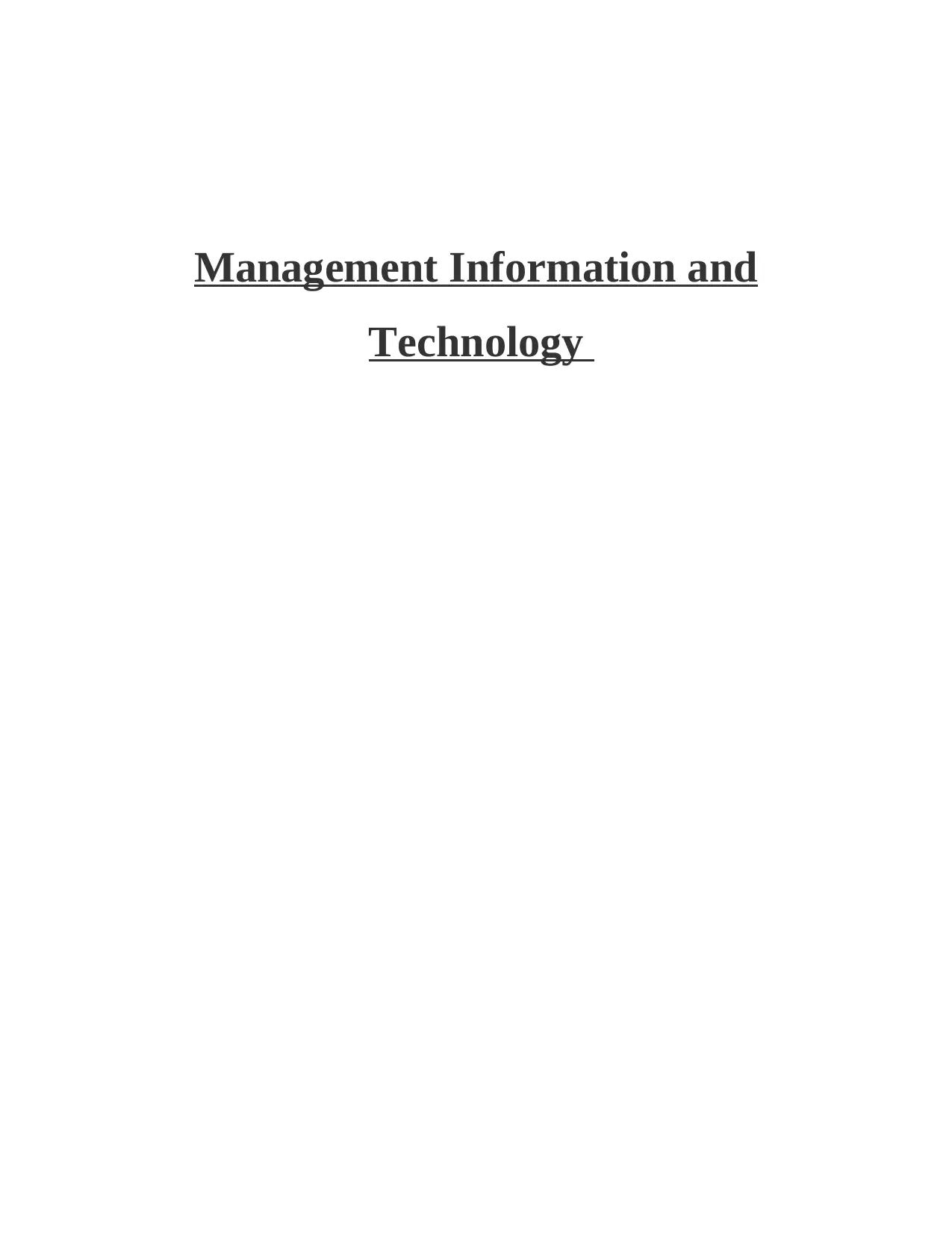
Management Information and
Technology
Technology
Paraphrase This Document
Need a fresh take? Get an instant paraphrase of this document with our AI Paraphraser
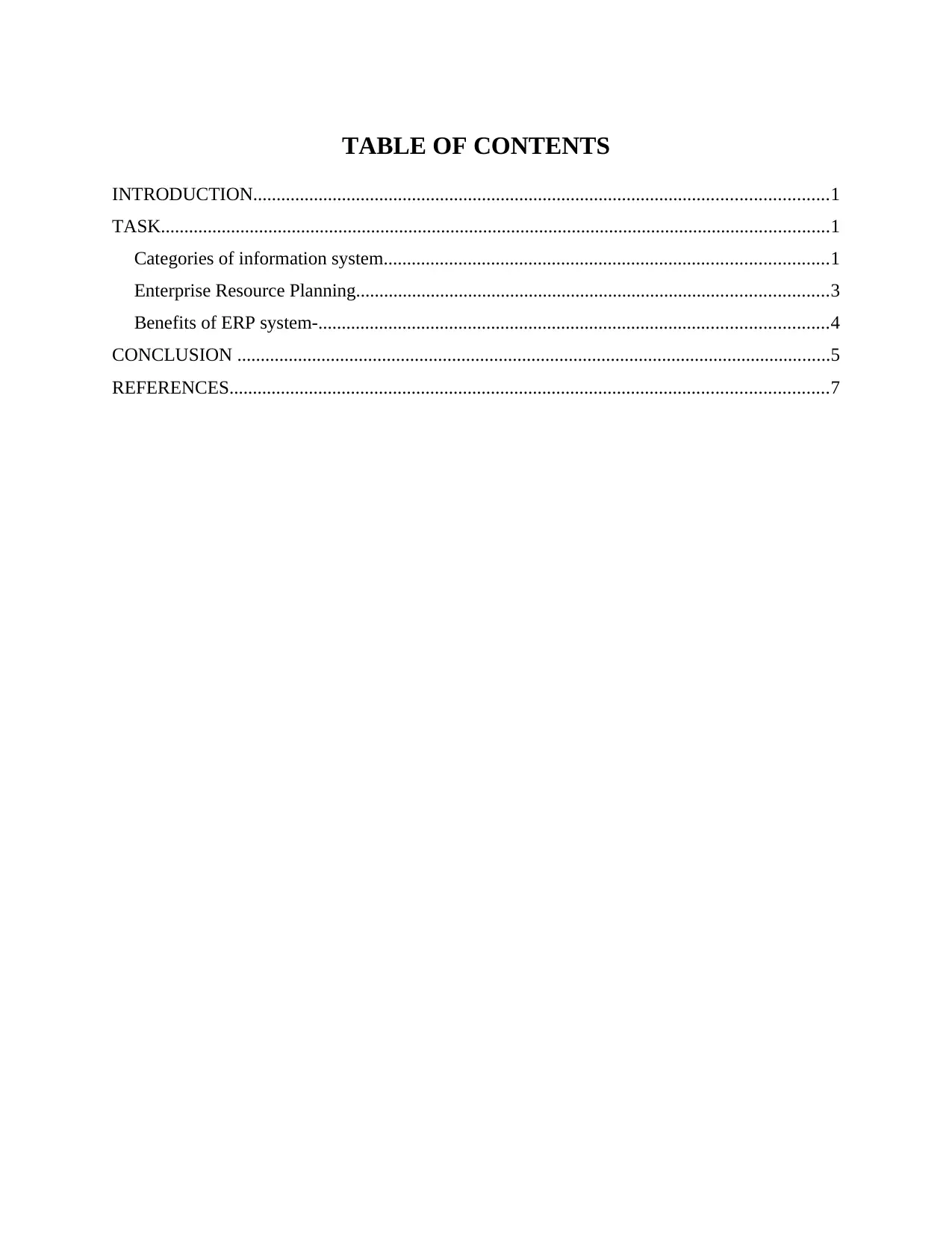
TABLE OF CONTENTS
INTRODUCTION...........................................................................................................................1
TASK...............................................................................................................................................1
Categories of information system...............................................................................................1
Enterprise Resource Planning.....................................................................................................3
Benefits of ERP system-.............................................................................................................4
CONCLUSION ...............................................................................................................................5
REFERENCES................................................................................................................................7
INTRODUCTION...........................................................................................................................1
TASK...............................................................................................................................................1
Categories of information system...............................................................................................1
Enterprise Resource Planning.....................................................................................................3
Benefits of ERP system-.............................................................................................................4
CONCLUSION ...............................................................................................................................5
REFERENCES................................................................................................................................7
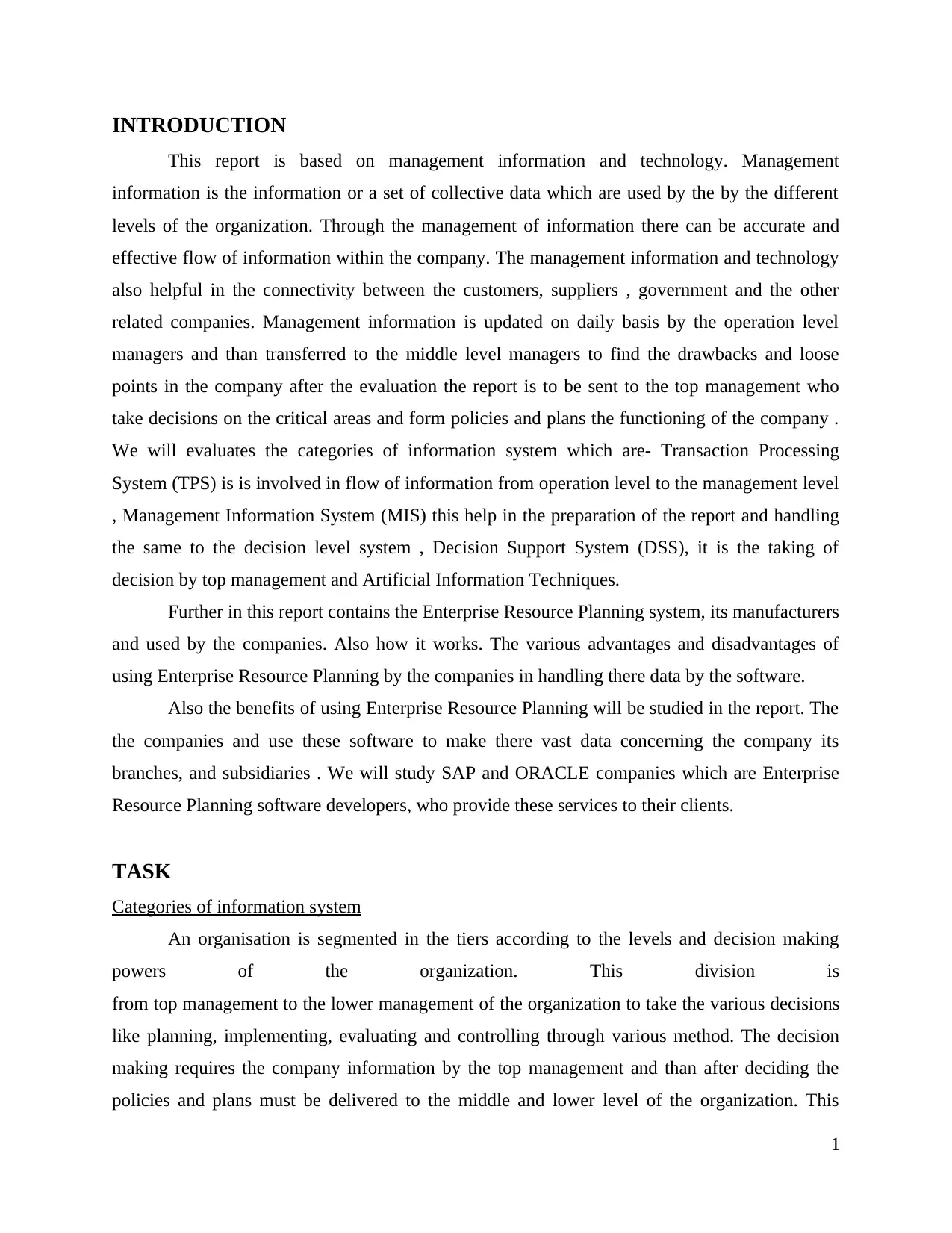
INTRODUCTION
This report is based on management information and technology. Management
information is the information or a set of collective data which are used by the by the different
levels of the organization. Through the management of information there can be accurate and
effective flow of information within the company. The management information and technology
also helpful in the connectivity between the customers, suppliers , government and the other
related companies. Management information is updated on daily basis by the operation level
managers and than transferred to the middle level managers to find the drawbacks and loose
points in the company after the evaluation the report is to be sent to the top management who
take decisions on the critical areas and form policies and plans the functioning of the company .
We will evaluates the categories of information system which are- Transaction Processing
System (TPS) is is involved in flow of information from operation level to the management level
, Management Information System (MIS) this help in the preparation of the report and handling
the same to the decision level system , Decision Support System (DSS), it is the taking of
decision by top management and Artificial Information Techniques.
Further in this report contains the Enterprise Resource Planning system, its manufacturers
and used by the companies. Also how it works. The various advantages and disadvantages of
using Enterprise Resource Planning by the companies in handling there data by the software.
Also the benefits of using Enterprise Resource Planning will be studied in the report. The
the companies and use these software to make there vast data concerning the company its
branches, and subsidiaries . We will study SAP and ORACLE companies which are Enterprise
Resource Planning software developers, who provide these services to their clients.
TASK
Categories of information system
An organisation is segmented in the tiers according to the levels and decision making
powers of the organization. This division is
from top management to the lower management of the organization to take the various decisions
like planning, implementing, evaluating and controlling through various method. The decision
making requires the company information by the top management and than after deciding the
policies and plans must be delivered to the middle and lower level of the organization. This
1
This report is based on management information and technology. Management
information is the information or a set of collective data which are used by the by the different
levels of the organization. Through the management of information there can be accurate and
effective flow of information within the company. The management information and technology
also helpful in the connectivity between the customers, suppliers , government and the other
related companies. Management information is updated on daily basis by the operation level
managers and than transferred to the middle level managers to find the drawbacks and loose
points in the company after the evaluation the report is to be sent to the top management who
take decisions on the critical areas and form policies and plans the functioning of the company .
We will evaluates the categories of information system which are- Transaction Processing
System (TPS) is is involved in flow of information from operation level to the management level
, Management Information System (MIS) this help in the preparation of the report and handling
the same to the decision level system , Decision Support System (DSS), it is the taking of
decision by top management and Artificial Information Techniques.
Further in this report contains the Enterprise Resource Planning system, its manufacturers
and used by the companies. Also how it works. The various advantages and disadvantages of
using Enterprise Resource Planning by the companies in handling there data by the software.
Also the benefits of using Enterprise Resource Planning will be studied in the report. The
the companies and use these software to make there vast data concerning the company its
branches, and subsidiaries . We will study SAP and ORACLE companies which are Enterprise
Resource Planning software developers, who provide these services to their clients.
TASK
Categories of information system
An organisation is segmented in the tiers according to the levels and decision making
powers of the organization. This division is
from top management to the lower management of the organization to take the various decisions
like planning, implementing, evaluating and controlling through various method. The decision
making requires the company information by the top management and than after deciding the
policies and plans must be delivered to the middle and lower level of the organization. This
1
⊘ This is a preview!⊘
Do you want full access?
Subscribe today to unlock all pages.

Trusted by 1+ million students worldwide
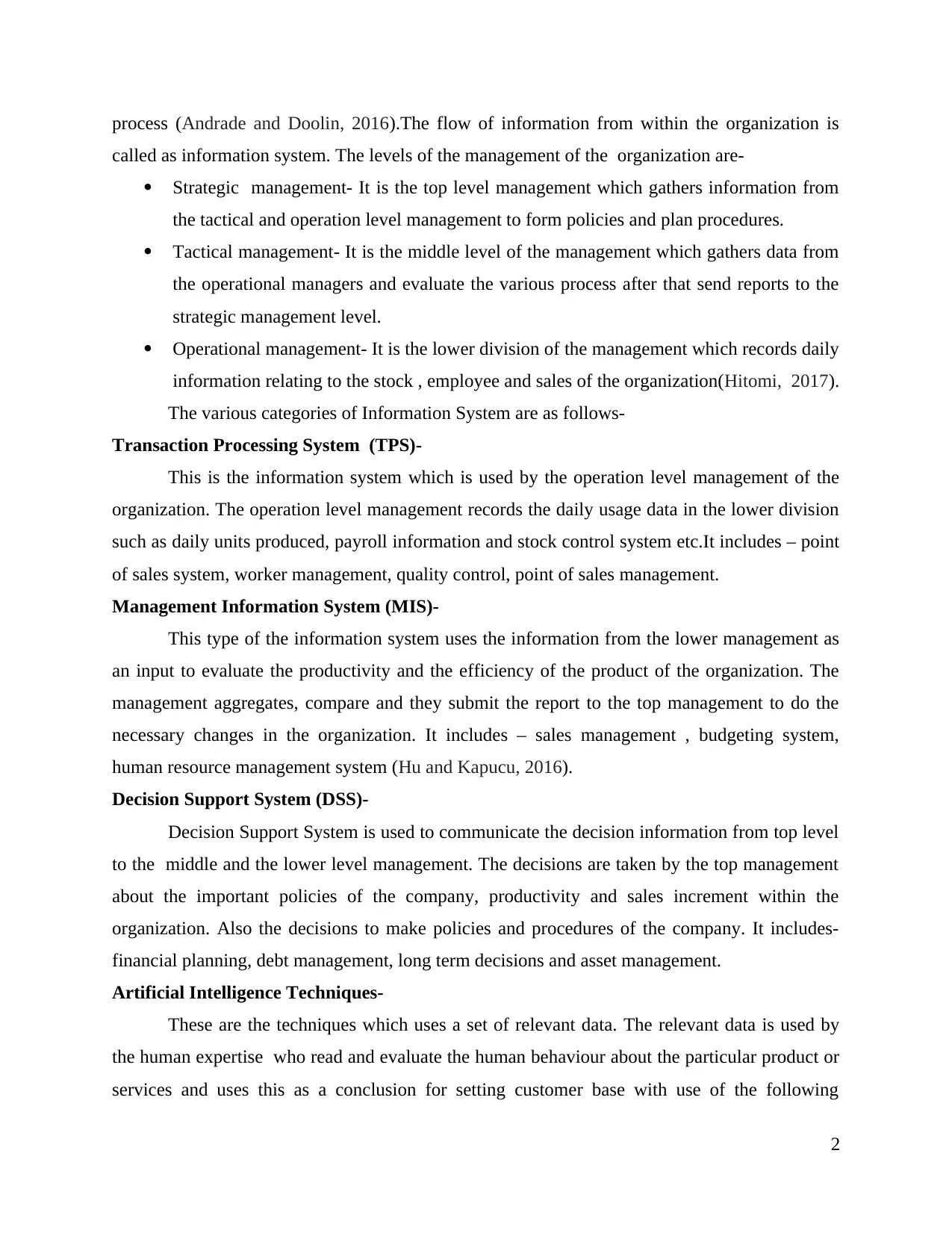
process (Andrade and Doolin, 2016).The flow of information from within the organization is
called as information system. The levels of the management of the organization are-
Strategic management- It is the top level management which gathers information from
the tactical and operation level management to form policies and plan procedures.
Tactical management- It is the middle level of the management which gathers data from
the operational managers and evaluate the various process after that send reports to the
strategic management level.
Operational management- It is the lower division of the management which records daily
information relating to the stock , employee and sales of the organization(Hitomi, 2017).
The various categories of Information System are as follows-
Transaction Processing System (TPS)-
This is the information system which is used by the operation level management of the
organization. The operation level management records the daily usage data in the lower division
such as daily units produced, payroll information and stock control system etc.It includes – point
of sales system, worker management, quality control, point of sales management.
Management Information System (MIS)-
This type of the information system uses the information from the lower management as
an input to evaluate the productivity and the efficiency of the product of the organization. The
management aggregates, compare and they submit the report to the top management to do the
necessary changes in the organization. It includes – sales management , budgeting system,
human resource management system (Hu and Kapucu, 2016).
Decision Support System (DSS)-
Decision Support System is used to communicate the decision information from top level
to the middle and the lower level management. The decisions are taken by the top management
about the important policies of the company, productivity and sales increment within the
organization. Also the decisions to make policies and procedures of the company. It includes-
financial planning, debt management, long term decisions and asset management.
Artificial Intelligence Techniques-
These are the techniques which uses a set of relevant data. The relevant data is used by
the human expertise who read and evaluate the human behaviour about the particular product or
services and uses this as a conclusion for setting customer base with use of the following
2
called as information system. The levels of the management of the organization are-
Strategic management- It is the top level management which gathers information from
the tactical and operation level management to form policies and plan procedures.
Tactical management- It is the middle level of the management which gathers data from
the operational managers and evaluate the various process after that send reports to the
strategic management level.
Operational management- It is the lower division of the management which records daily
information relating to the stock , employee and sales of the organization(Hitomi, 2017).
The various categories of Information System are as follows-
Transaction Processing System (TPS)-
This is the information system which is used by the operation level management of the
organization. The operation level management records the daily usage data in the lower division
such as daily units produced, payroll information and stock control system etc.It includes – point
of sales system, worker management, quality control, point of sales management.
Management Information System (MIS)-
This type of the information system uses the information from the lower management as
an input to evaluate the productivity and the efficiency of the product of the organization. The
management aggregates, compare and they submit the report to the top management to do the
necessary changes in the organization. It includes – sales management , budgeting system,
human resource management system (Hu and Kapucu, 2016).
Decision Support System (DSS)-
Decision Support System is used to communicate the decision information from top level
to the middle and the lower level management. The decisions are taken by the top management
about the important policies of the company, productivity and sales increment within the
organization. Also the decisions to make policies and procedures of the company. It includes-
financial planning, debt management, long term decisions and asset management.
Artificial Intelligence Techniques-
These are the techniques which uses a set of relevant data. The relevant data is used by
the human expertise who read and evaluate the human behaviour about the particular product or
services and uses this as a conclusion for setting customer base with use of the following
2
Paraphrase This Document
Need a fresh take? Get an instant paraphrase of this document with our AI Paraphraser
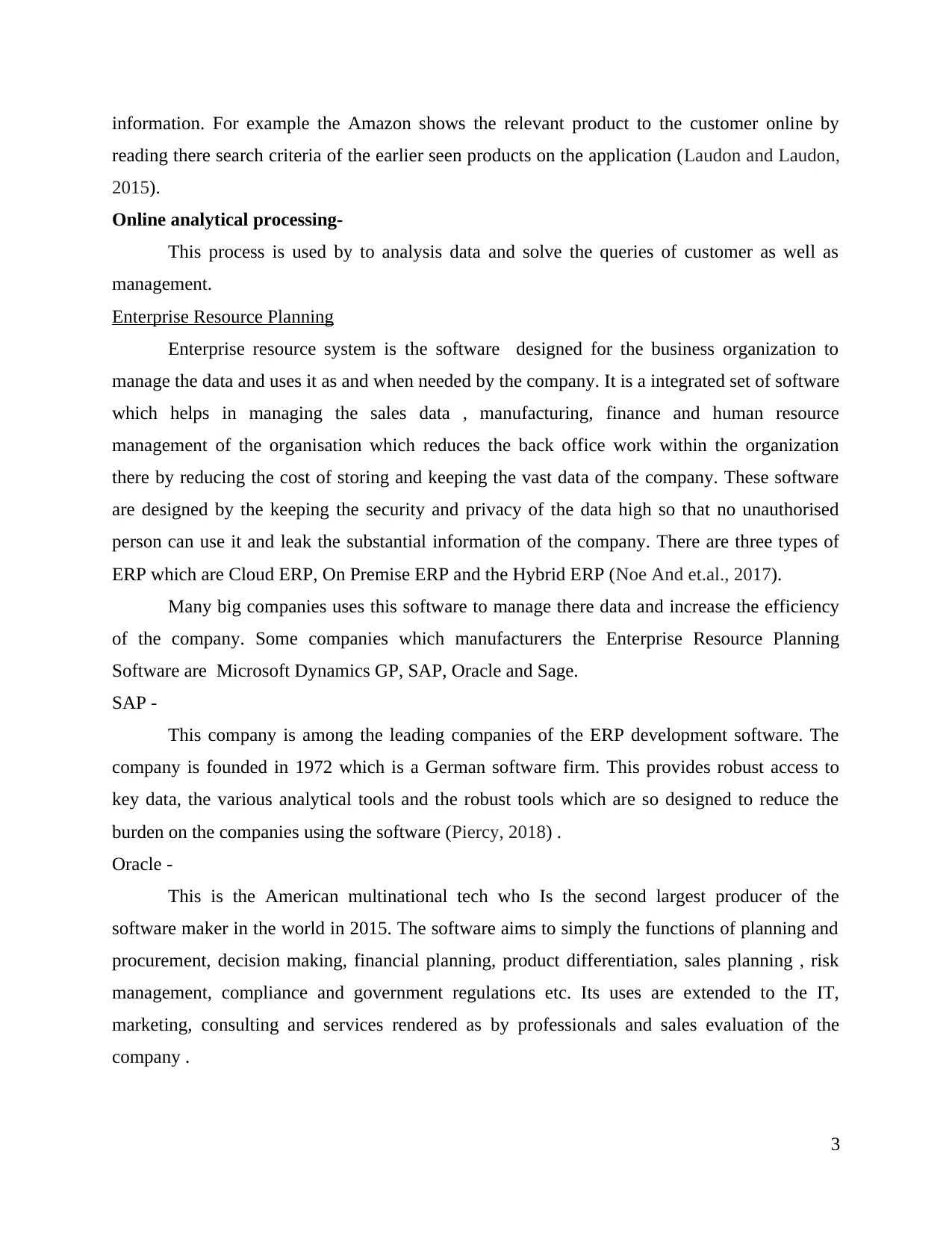
information. For example the Amazon shows the relevant product to the customer online by
reading there search criteria of the earlier seen products on the application (Laudon and Laudon,
2015).
Online analytical processing-
This process is used by to analysis data and solve the queries of customer as well as
management.
Enterprise Resource Planning
Enterprise resource system is the software designed for the business organization to
manage the data and uses it as and when needed by the company. It is a integrated set of software
which helps in managing the sales data , manufacturing, finance and human resource
management of the organisation which reduces the back office work within the organization
there by reducing the cost of storing and keeping the vast data of the company. These software
are designed by the keeping the security and privacy of the data high so that no unauthorised
person can use it and leak the substantial information of the company. There are three types of
ERP which are Cloud ERP, On Premise ERP and the Hybrid ERP (Noe And et.al., 2017).
Many big companies uses this software to manage there data and increase the efficiency
of the company. Some companies which manufacturers the Enterprise Resource Planning
Software are Microsoft Dynamics GP, SAP, Oracle and Sage.
SAP -
This company is among the leading companies of the ERP development software. The
company is founded in 1972 which is a German software firm. This provides robust access to
key data, the various analytical tools and the robust tools which are so designed to reduce the
burden on the companies using the software (Piercy, 2018) .
Oracle -
This is the American multinational tech who Is the second largest producer of the
software maker in the world in 2015. The software aims to simply the functions of planning and
procurement, decision making, financial planning, product differentiation, sales planning , risk
management, compliance and government regulations etc. Its uses are extended to the IT,
marketing, consulting and services rendered as by professionals and sales evaluation of the
company .
3
reading there search criteria of the earlier seen products on the application (Laudon and Laudon,
2015).
Online analytical processing-
This process is used by to analysis data and solve the queries of customer as well as
management.
Enterprise Resource Planning
Enterprise resource system is the software designed for the business organization to
manage the data and uses it as and when needed by the company. It is a integrated set of software
which helps in managing the sales data , manufacturing, finance and human resource
management of the organisation which reduces the back office work within the organization
there by reducing the cost of storing and keeping the vast data of the company. These software
are designed by the keeping the security and privacy of the data high so that no unauthorised
person can use it and leak the substantial information of the company. There are three types of
ERP which are Cloud ERP, On Premise ERP and the Hybrid ERP (Noe And et.al., 2017).
Many big companies uses this software to manage there data and increase the efficiency
of the company. Some companies which manufacturers the Enterprise Resource Planning
Software are Microsoft Dynamics GP, SAP, Oracle and Sage.
SAP -
This company is among the leading companies of the ERP development software. The
company is founded in 1972 which is a German software firm. This provides robust access to
key data, the various analytical tools and the robust tools which are so designed to reduce the
burden on the companies using the software (Piercy, 2018) .
Oracle -
This is the American multinational tech who Is the second largest producer of the
software maker in the world in 2015. The software aims to simply the functions of planning and
procurement, decision making, financial planning, product differentiation, sales planning , risk
management, compliance and government regulations etc. Its uses are extended to the IT,
marketing, consulting and services rendered as by professionals and sales evaluation of the
company .
3
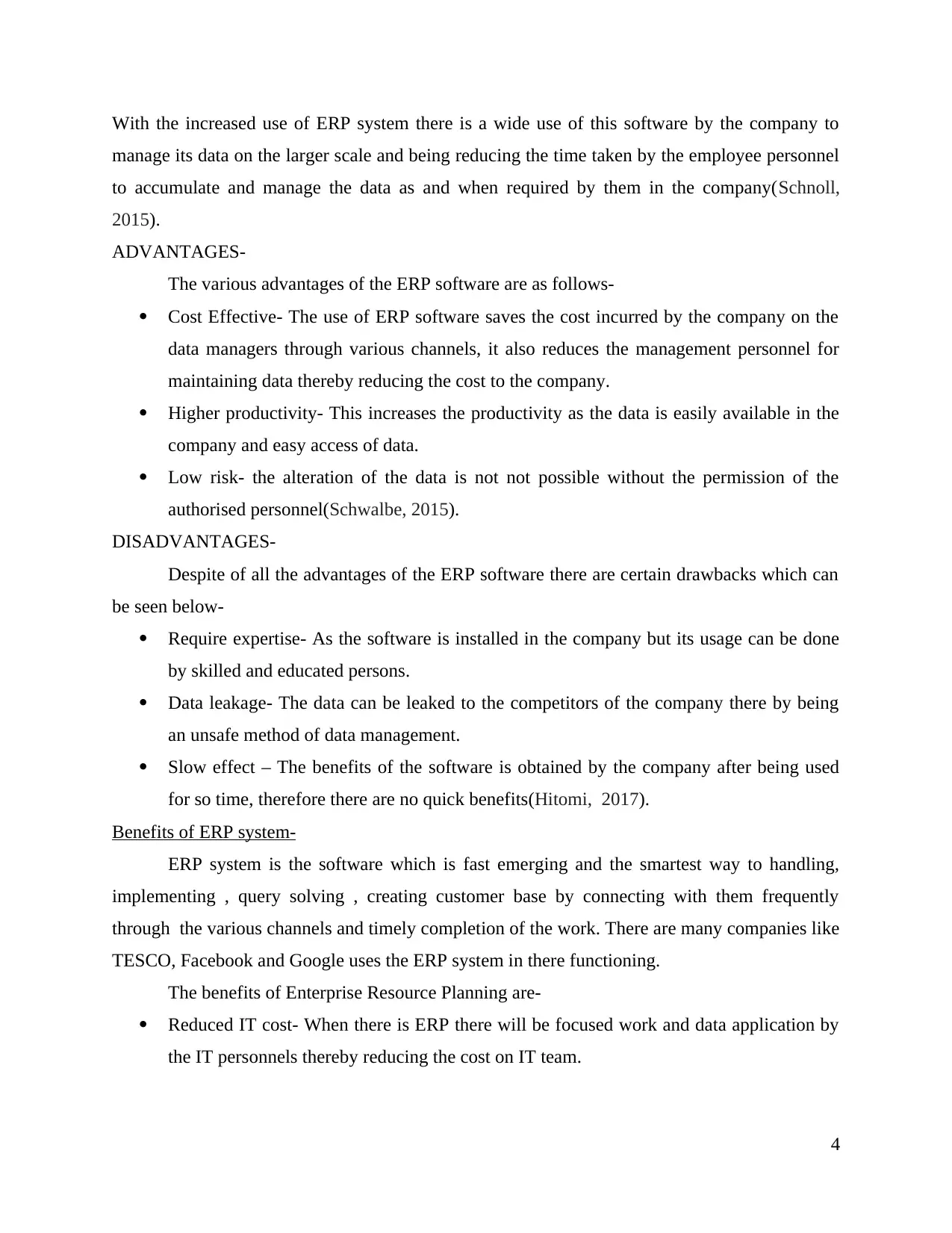
With the increased use of ERP system there is a wide use of this software by the company to
manage its data on the larger scale and being reducing the time taken by the employee personnel
to accumulate and manage the data as and when required by them in the company(Schnoll,
2015).
ADVANTAGES-
The various advantages of the ERP software are as follows-
Cost Effective- The use of ERP software saves the cost incurred by the company on the
data managers through various channels, it also reduces the management personnel for
maintaining data thereby reducing the cost to the company.
Higher productivity- This increases the productivity as the data is easily available in the
company and easy access of data.
Low risk- the alteration of the data is not not possible without the permission of the
authorised personnel(Schwalbe, 2015).
DISADVANTAGES-
Despite of all the advantages of the ERP software there are certain drawbacks which can
be seen below-
Require expertise- As the software is installed in the company but its usage can be done
by skilled and educated persons.
Data leakage- The data can be leaked to the competitors of the company there by being
an unsafe method of data management.
Slow effect – The benefits of the software is obtained by the company after being used
for so time, therefore there are no quick benefits(Hitomi, 2017).
Benefits of ERP system-
ERP system is the software which is fast emerging and the smartest way to handling,
implementing , query solving , creating customer base by connecting with them frequently
through the various channels and timely completion of the work. There are many companies like
TESCO, Facebook and Google uses the ERP system in there functioning.
The benefits of Enterprise Resource Planning are-
Reduced IT cost- When there is ERP there will be focused work and data application by
the IT personnels thereby reducing the cost on IT team.
4
manage its data on the larger scale and being reducing the time taken by the employee personnel
to accumulate and manage the data as and when required by them in the company(Schnoll,
2015).
ADVANTAGES-
The various advantages of the ERP software are as follows-
Cost Effective- The use of ERP software saves the cost incurred by the company on the
data managers through various channels, it also reduces the management personnel for
maintaining data thereby reducing the cost to the company.
Higher productivity- This increases the productivity as the data is easily available in the
company and easy access of data.
Low risk- the alteration of the data is not not possible without the permission of the
authorised personnel(Schwalbe, 2015).
DISADVANTAGES-
Despite of all the advantages of the ERP software there are certain drawbacks which can
be seen below-
Require expertise- As the software is installed in the company but its usage can be done
by skilled and educated persons.
Data leakage- The data can be leaked to the competitors of the company there by being
an unsafe method of data management.
Slow effect – The benefits of the software is obtained by the company after being used
for so time, therefore there are no quick benefits(Hitomi, 2017).
Benefits of ERP system-
ERP system is the software which is fast emerging and the smartest way to handling,
implementing , query solving , creating customer base by connecting with them frequently
through the various channels and timely completion of the work. There are many companies like
TESCO, Facebook and Google uses the ERP system in there functioning.
The benefits of Enterprise Resource Planning are-
Reduced IT cost- When there is ERP there will be focused work and data application by
the IT personnels thereby reducing the cost on IT team.
4
⊘ This is a preview!⊘
Do you want full access?
Subscribe today to unlock all pages.

Trusted by 1+ million students worldwide
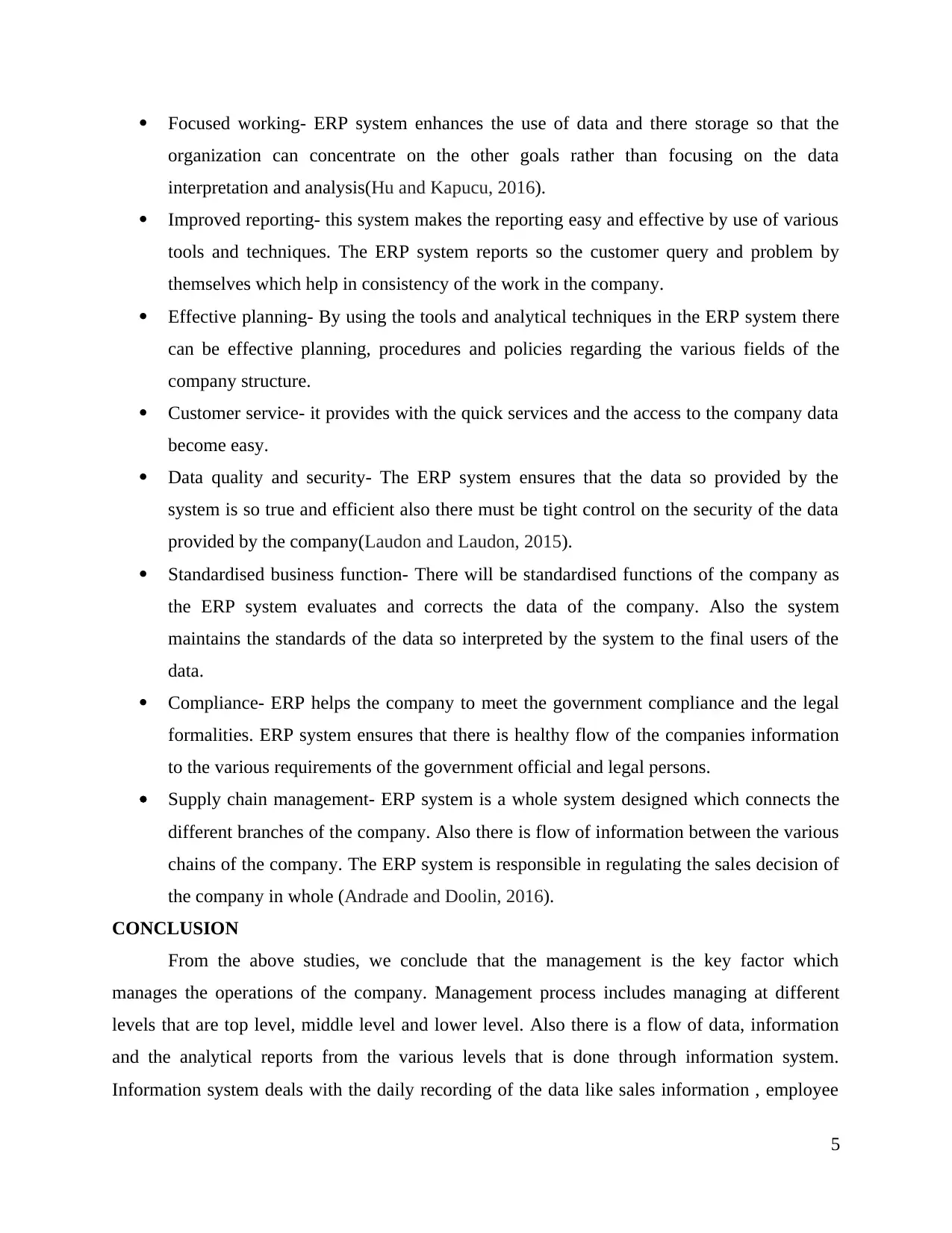
Focused working- ERP system enhances the use of data and there storage so that the
organization can concentrate on the other goals rather than focusing on the data
interpretation and analysis(Hu and Kapucu, 2016).
Improved reporting- this system makes the reporting easy and effective by use of various
tools and techniques. The ERP system reports so the customer query and problem by
themselves which help in consistency of the work in the company.
Effective planning- By using the tools and analytical techniques in the ERP system there
can be effective planning, procedures and policies regarding the various fields of the
company structure.
Customer service- it provides with the quick services and the access to the company data
become easy.
Data quality and security- The ERP system ensures that the data so provided by the
system is so true and efficient also there must be tight control on the security of the data
provided by the company(Laudon and Laudon, 2015).
Standardised business function- There will be standardised functions of the company as
the ERP system evaluates and corrects the data of the company. Also the system
maintains the standards of the data so interpreted by the system to the final users of the
data.
Compliance- ERP helps the company to meet the government compliance and the legal
formalities. ERP system ensures that there is healthy flow of the companies information
to the various requirements of the government official and legal persons.
Supply chain management- ERP system is a whole system designed which connects the
different branches of the company. Also there is flow of information between the various
chains of the company. The ERP system is responsible in regulating the sales decision of
the company in whole (Andrade and Doolin, 2016).
CONCLUSION
From the above studies, we conclude that the management is the key factor which
manages the operations of the company. Management process includes managing at different
levels that are top level, middle level and lower level. Also there is a flow of data, information
and the analytical reports from the various levels that is done through information system.
Information system deals with the daily recording of the data like sales information , employee
5
organization can concentrate on the other goals rather than focusing on the data
interpretation and analysis(Hu and Kapucu, 2016).
Improved reporting- this system makes the reporting easy and effective by use of various
tools and techniques. The ERP system reports so the customer query and problem by
themselves which help in consistency of the work in the company.
Effective planning- By using the tools and analytical techniques in the ERP system there
can be effective planning, procedures and policies regarding the various fields of the
company structure.
Customer service- it provides with the quick services and the access to the company data
become easy.
Data quality and security- The ERP system ensures that the data so provided by the
system is so true and efficient also there must be tight control on the security of the data
provided by the company(Laudon and Laudon, 2015).
Standardised business function- There will be standardised functions of the company as
the ERP system evaluates and corrects the data of the company. Also the system
maintains the standards of the data so interpreted by the system to the final users of the
data.
Compliance- ERP helps the company to meet the government compliance and the legal
formalities. ERP system ensures that there is healthy flow of the companies information
to the various requirements of the government official and legal persons.
Supply chain management- ERP system is a whole system designed which connects the
different branches of the company. Also there is flow of information between the various
chains of the company. The ERP system is responsible in regulating the sales decision of
the company in whole (Andrade and Doolin, 2016).
CONCLUSION
From the above studies, we conclude that the management is the key factor which
manages the operations of the company. Management process includes managing at different
levels that are top level, middle level and lower level. Also there is a flow of data, information
and the analytical reports from the various levels that is done through information system.
Information system deals with the daily recording of the data like sales information , employee
5
Paraphrase This Document
Need a fresh take? Get an instant paraphrase of this document with our AI Paraphraser
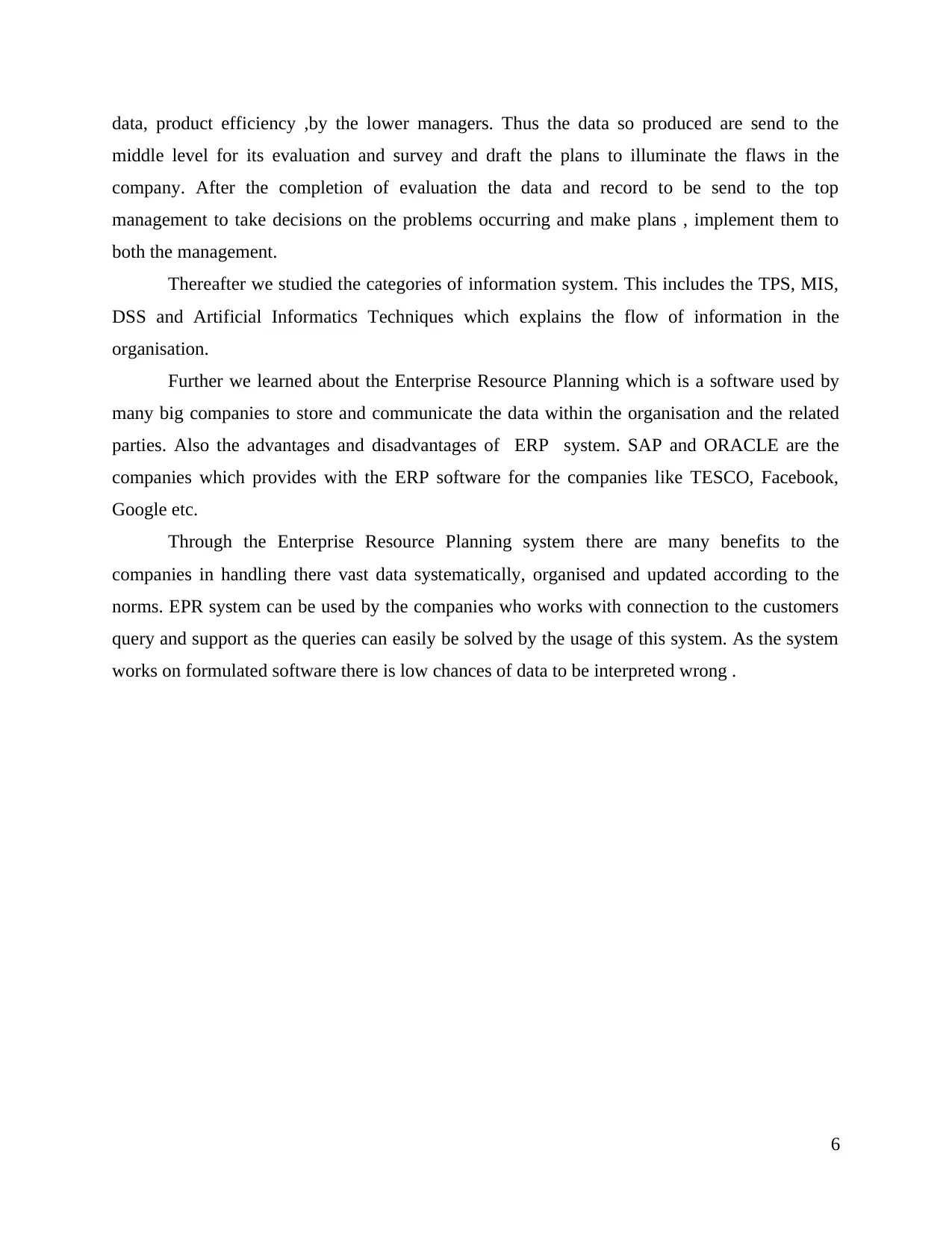
data, product efficiency ,by the lower managers. Thus the data so produced are send to the
middle level for its evaluation and survey and draft the plans to illuminate the flaws in the
company. After the completion of evaluation the data and record to be send to the top
management to take decisions on the problems occurring and make plans , implement them to
both the management.
Thereafter we studied the categories of information system. This includes the TPS, MIS,
DSS and Artificial Informatics Techniques which explains the flow of information in the
organisation.
Further we learned about the Enterprise Resource Planning which is a software used by
many big companies to store and communicate the data within the organisation and the related
parties. Also the advantages and disadvantages of ERP system. SAP and ORACLE are the
companies which provides with the ERP software for the companies like TESCO, Facebook,
Google etc.
Through the Enterprise Resource Planning system there are many benefits to the
companies in handling there vast data systematically, organised and updated according to the
norms. EPR system can be used by the companies who works with connection to the customers
query and support as the queries can easily be solved by the usage of this system. As the system
works on formulated software there is low chances of data to be interpreted wrong .
6
middle level for its evaluation and survey and draft the plans to illuminate the flaws in the
company. After the completion of evaluation the data and record to be send to the top
management to take decisions on the problems occurring and make plans , implement them to
both the management.
Thereafter we studied the categories of information system. This includes the TPS, MIS,
DSS and Artificial Informatics Techniques which explains the flow of information in the
organisation.
Further we learned about the Enterprise Resource Planning which is a software used by
many big companies to store and communicate the data within the organisation and the related
parties. Also the advantages and disadvantages of ERP system. SAP and ORACLE are the
companies which provides with the ERP software for the companies like TESCO, Facebook,
Google etc.
Through the Enterprise Resource Planning system there are many benefits to the
companies in handling there vast data systematically, organised and updated according to the
norms. EPR system can be used by the companies who works with connection to the customers
query and support as the queries can easily be solved by the usage of this system. As the system
works on formulated software there is low chances of data to be interpreted wrong .
6
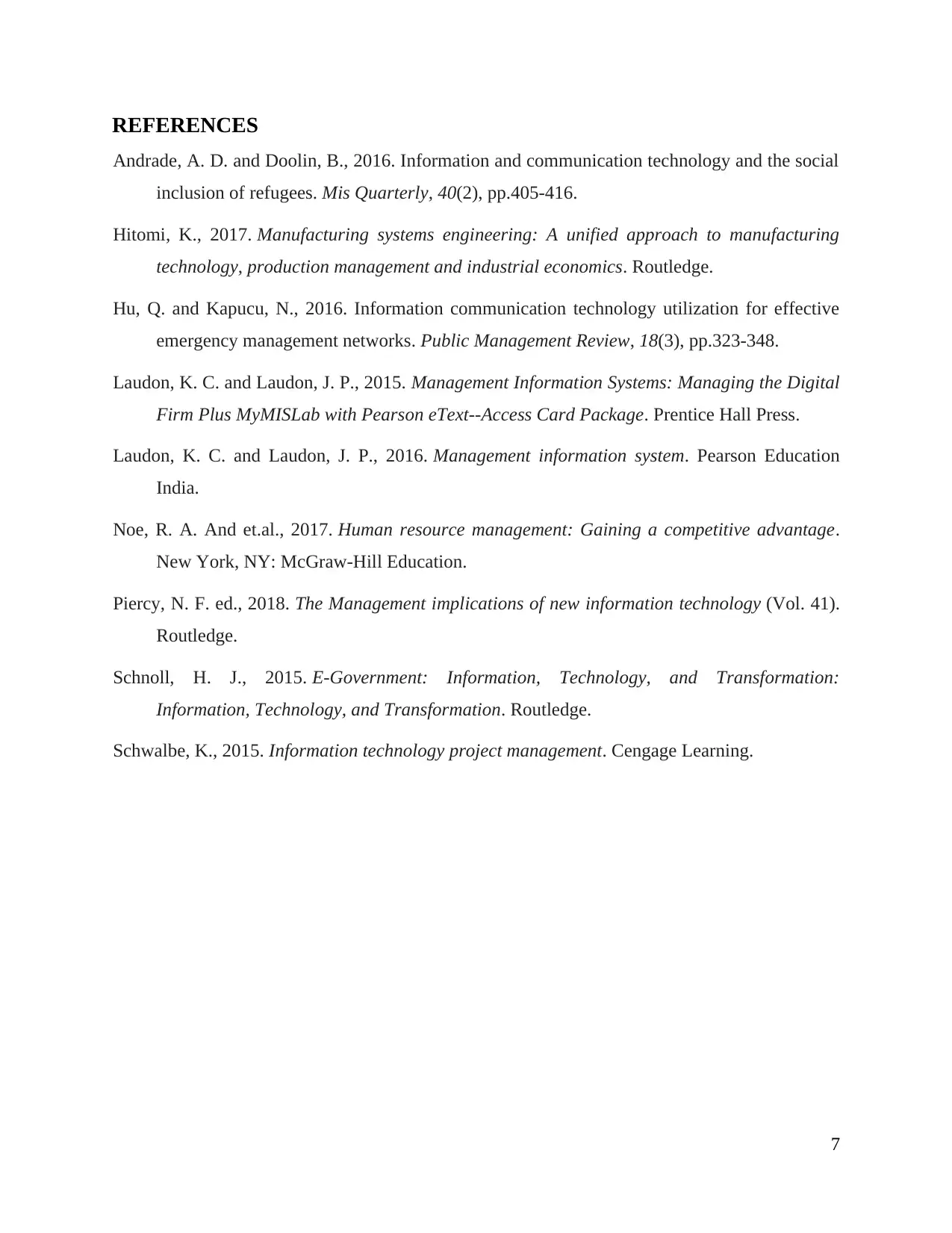
REFERENCES
Andrade, A. D. and Doolin, B., 2016. Information and communication technology and the social
inclusion of refugees. Mis Quarterly, 40(2), pp.405-416.
Hitomi, K., 2017. Manufacturing systems engineering: A unified approach to manufacturing
technology, production management and industrial economics. Routledge.
Hu, Q. and Kapucu, N., 2016. Information communication technology utilization for effective
emergency management networks. Public Management Review, 18(3), pp.323-348.
Laudon, K. C. and Laudon, J. P., 2015. Management Information Systems: Managing the Digital
Firm Plus MyMISLab with Pearson eText--Access Card Package. Prentice Hall Press.
Laudon, K. C. and Laudon, J. P., 2016. Management information system. Pearson Education
India.
Noe, R. A. And et.al., 2017. Human resource management: Gaining a competitive advantage.
New York, NY: McGraw-Hill Education.
Piercy, N. F. ed., 2018. The Management implications of new information technology (Vol. 41).
Routledge.
Schnoll, H. J., 2015. E-Government: Information, Technology, and Transformation:
Information, Technology, and Transformation. Routledge.
Schwalbe, K., 2015. Information technology project management. Cengage Learning.
7
Andrade, A. D. and Doolin, B., 2016. Information and communication technology and the social
inclusion of refugees. Mis Quarterly, 40(2), pp.405-416.
Hitomi, K., 2017. Manufacturing systems engineering: A unified approach to manufacturing
technology, production management and industrial economics. Routledge.
Hu, Q. and Kapucu, N., 2016. Information communication technology utilization for effective
emergency management networks. Public Management Review, 18(3), pp.323-348.
Laudon, K. C. and Laudon, J. P., 2015. Management Information Systems: Managing the Digital
Firm Plus MyMISLab with Pearson eText--Access Card Package. Prentice Hall Press.
Laudon, K. C. and Laudon, J. P., 2016. Management information system. Pearson Education
India.
Noe, R. A. And et.al., 2017. Human resource management: Gaining a competitive advantage.
New York, NY: McGraw-Hill Education.
Piercy, N. F. ed., 2018. The Management implications of new information technology (Vol. 41).
Routledge.
Schnoll, H. J., 2015. E-Government: Information, Technology, and Transformation:
Information, Technology, and Transformation. Routledge.
Schwalbe, K., 2015. Information technology project management. Cengage Learning.
7
⊘ This is a preview!⊘
Do you want full access?
Subscribe today to unlock all pages.

Trusted by 1+ million students worldwide
1 out of 9
Related Documents
Your All-in-One AI-Powered Toolkit for Academic Success.
+13062052269
info@desklib.com
Available 24*7 on WhatsApp / Email
![[object Object]](/_next/static/media/star-bottom.7253800d.svg)
Unlock your academic potential
Copyright © 2020–2025 A2Z Services. All Rights Reserved. Developed and managed by ZUCOL.




